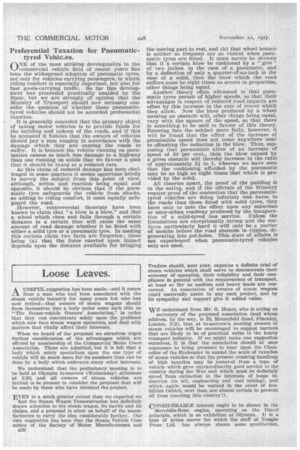Preferential Taxation for Pneumatictyred Vehickes.
Page 114

If you've noticed an error in this article please click here to report it so we can fix it.
CANE of the most striking developments in the ‘.../commercial vehicle field of recent years has been the widespread adoption of pneumatic tyres, not only for vehicles carrying passengers, in which riding comfort is especially important, but also for Last goods-carrying traffic. So far this development has proceeded practically unaided by the State, but we are strongly of opinion that the Ministry of Transport should now seriously consider the question of whether these pneumatictyred vehicles should not be accorded preferential taxation.
It is generally conceded that the primary object of taxing motor vehicles is to provide funds for the building and upkeep of the roads, and if this be accepted it follows that the owners of vehicles should pay a sum roughly in accordance with the damage which they are causing the roads to suffer. It is because the vehicle running on pneumatics causes so much less damage to a highway than one running on solids that we favour a plea that it should be taxed at a reduced rate. As this claim of reduced damage has been challenged in some quarters it seems opportune briefly to survey the subject from this point of view, although, action and reaction being equal and opposite, it should be obvious that if the pneumatic tyre safeguards the vehicle from shocks, so adding to riding comfort, it must equally safeguard the road. However, controversial theorists have been known to claim that "a blow is a blow," and that a wheel which rises and falls through a certain distance in a certain time will cause the same amount of road damage whether it be fitted with either a solid tyre or a pneumatic tyre. In making this curious claim two facts are forgotten ; these being (a) that the force exerted upon impact depends upon the distance available for bringing the moving part to rest, and (b) that wheel bounce Is neither so frequent nor so violent when pneumatic tyres are fitted. It must surely be obvious that if a certain blow be cushioned by a " give " of two inches in the ease of a pneumatic, and by a deflection of only a quarter-of-an-inch in the case of a solid, then the blow which the road suffers must be eight times as severe in proportion, other things being equal. Another theory often advanced is that pneumatic tyres permit of higher speeds, so that their advantages in respect of reduced road impacts are offset by this increase in the rate of travel which they allow. Now the blow produced by a wheel meeting an obstacle will, other things being equal, vary with the square of the speed, so that there is something to be said in favour of this theory. Entering into the subject more fully, however, it will be found that the effect of the increase of permissible speed does not come anywhere near to offsetting the reduction in the blow. Thus, supposing that pneumatics allow of an increase of speed of 50 per cent., then the blow caused by a given obstacle will thereby increase in the ratio of approximately 21 to 1, whereas we have seen that the cushioning afforded by the pneumatic may be as high as eight times that which is provided by the solid. All theories apart, the proof of the pudding is in the eating, and if the officials of the Ministry require proof of the contention that the pneumatictyred vehicles are doing infinitely less harm to the roads than those fitted with solid tyres, they have only to note the effect upon any suburban or inter-urban roadway produced by the inauguration of a solid-tyred bus service. Unless the foundations are exceptionally strong and the Surfaces particularly hard it will only be a matter of months before the road abounds in ripples, degenerating into pot-holes. This state of affairs is not experienced when pneumatic-tyred vehicles only are used.


















































































































































































































































































































